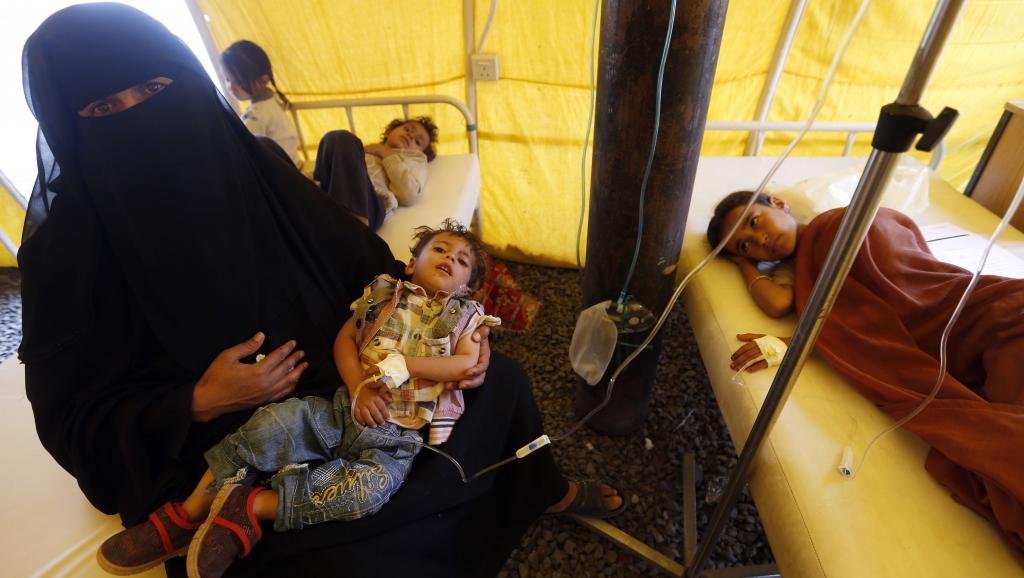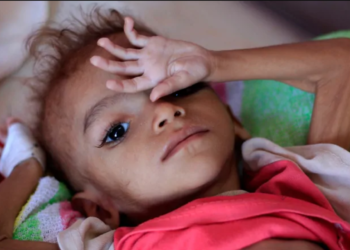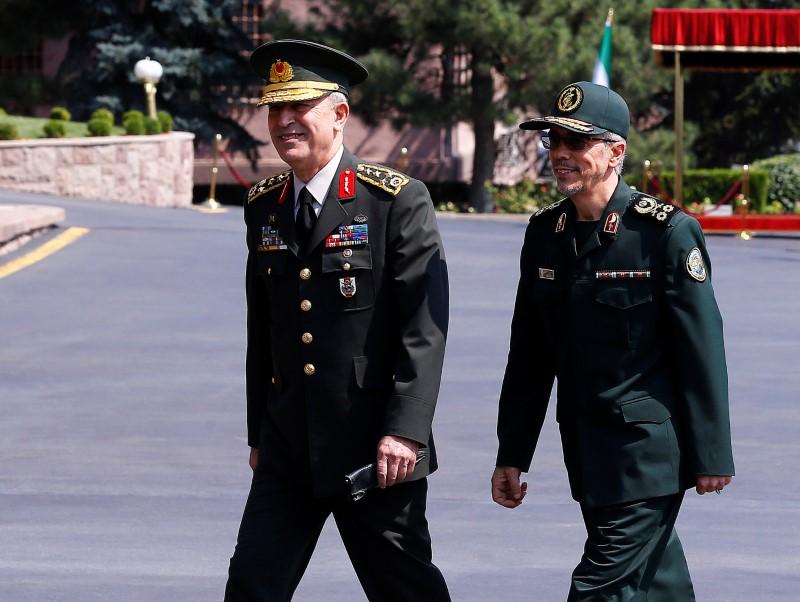The final death toll from the resurgence of cholera in Yemen in the spring and summer of 2017 has yet to be seen, but images from aid agencies and reporters on the ground paint a dire picture. Frail men and women, young and old, lie on flimsy hospital beds as harried doctors try to contain their symptoms.
According to World Health Organization figures, the cholera outbreak has killed 1,953 people as of August 6. Beginning on April 27, the disease quickly spread through a country where sanitation, food, medicine and even health workers have been hard to find. The WHO has recorded more than 473,700 suspected cholera cases in 22 of Yemen’s 23 governorates.
The source of the outbreak hasn’t been determined, but it notably struck just 10 days after the sewer system in the capital Sana’a stopped working.
Soumaya Beltifa, Communication Coordinator for the International Committee of the Red Cross told The Globe Post that the causes of the cholera outbreak were numerous:
“Many water pumping stations are not working because of a shortage of fuel in addition to the rainy season and the piled garbage in the streets,” she said.
Many of Yemen’s doctors and nurses – an estimated 30,000 healthcare workers in all – have not been paid or received a full salary since August 2016, but they are trying to save people’s lives nonetheless. A number of aid agencies are on the ground as well with the limited funding and even more restricted supplies they can get.
Cholera never went away in Yemen. This recent outbreak, which surged just as President Donald J. Trump was announcing a $110 billion weapons deal with Saudi Arabia, can be traced back to last autumn. Cases of the disease spiked in December and then dissipated before coming back this year.
The 2016 outbreak ultimately killed about 125 people, and although it waned it never really went away, and the bacteria were able to find a stronghold again among a population that is poor, tired and increasingly in danger from not only bombs but starvation.
Cholera has obscured the underlying threat to Yemenis, what some aid agencies are calling an entirely man-made food crisis.
Beyond cholera
Speaking in Sana’a on August 1, Auke Lootsma, U.N. Development Programme country director for Yemen, said nearly 2 million Yemeni children are malnourished.
“Malnutrition makes children more susceptible to cholera and at the same time diseases create more malnutrition, so if you look at it together it’s a deadly combination,” Lootsma said.
Between 14-17 million Yemenis – about 60 percent of the population – are food insecure, meaning they don’t have reliable access to nutritious food. The U.N. considers 24 percent of the Yemeni population to be emergency cases and 10.2 million people to be in a food crisis.
Yemen was the poorest nation in the region even before Saudi Arabia intervened in the fighting between President Abd Rabbuh Mansur Hadi’s government forces and the Houthi rebels in March 2015.
According to the U.N. Office of the High Commissioner for Human Rights, more than 13,000 civilians have been killed since the Saudi coalition began its air campaign, an estimated 60 percent from the bombardment. The overall death toll is closer to 16,000, but those people are considered by one side or another to be militants.
“Compounded by the displacement of two million people from their homes and the outbreak of disease, more lives are now at risk in Yemen than anywhere else in the world,” Suze van Meegen, protection and advocacy advisor for the Norwegian Refugee Council, told The Globe Post.
The NRC has been working in Yemen since 2012 and adapted their efforts following the escalation of violence in 2015 to focus on people displaced by the violence who need shelter, food, clean water and other aid.
Van Meegen said that the NGO’s work has not changed significantly since the height of the outbreak in June, but its approach continues to adapt to meet changing needs.
She explained that cholera is entirely preventable and many people can, and should, be able to survive the illness. But Yemenis were already starving when the outbreak began.
“The severity of the food security crisis, the high prevalence of acute malnutrition among women and children, and ongoing deterioration of basic service is increasing the vulnerability of millions of Yemenis to cholera and other diseases, and increasing the risk of death,” van Meegen said.
Critically, humanitarian organizations have had also had to divert funding from other areas in order to respond to the cholera outbreak.
Beltifa said the outbreak has made the ICRC focus its activities. The charity, which has been in Yemen since 2004, works in a number of areas such as emergency relief and general health, physical rehabilitation, water and sewage and support for incarcerated and detained people.
The ICRC is also helping the Yemeni Red Crescent Society build up its capacities.
In addition to pulling resources from shelter and other areas, educational efforts have been scaled back.
“The pressure on health facilities to respond to the cholera crisis has led to the closure of at least four schools for use as cholera treatment centres, contributing to a bigger picture of educational breakdown in Yemen,” van Meegen said.
In addition to having their schools adapted into medical facilities (in part to cope with the lack of bed space caused by the cholera outbreak), some of the buildings have been taken over by the military or the rebels or outright destroyed in the conflict. More than two million children who should be in school every day are not able to attend classes.
The numbers of people affected by conflict since 2011 can seem staggering: According to the UN Refugee Agency (UNHCR) and Yemeni government statistics, more than 478,000 people were internally displaced last year, bringing the number of Yemenis forced from their homes to more than 1.97 million since 2011. Additionally, there are around 278,000 refugees in Yemen from other nations, mostly Somalia, but including Ethiopia, Iraq and Syria.
Fourteen million people are without healthcare and clean water and, according to NRC, 1.7 million people are trapped in areas that are hard to reach due to fighting or impediments to food and humanitarian aid delivery.
More than 45 percent of health structures have stopped working or are only partially functional due to the conflict, Beltifa said. Even medications that are available are beyond the reach of most of the Yemeni population due to the expense.
Public hospitals, including those run by charities like Médecins Sans Frontières (also known as Doctors Without Borders) have been hit and destroyed by Saudi coalition airstrikes. MSF says it clearly identifies hospitals and shares the GPS coordinates of several medical facilities with the Saudi-led coalition.
The organization has noted that its facilities have sometimes been hit only days after the coordinates were provided to the coalition.
Looming threat of famine in Yemen
Following a five-day visit in May, NRC Secretary-General Jan Egeland warned that Yemen is at risk of an entirely man-made famine. Egeland said commercial food imports had dropped to an all-time low and prices had increased by a third on average.
Van Meegen told The Globe Post that the situation has failed to improve. “Yemen is facing an impending humanitarian catastrophe and a situation that continues to deteriorate,” she said.
NRC estimates that 21 million people – more than 75 percent of the population – are in need of aid and protection. Ten million need it immediately to survive.
“Yemen is experiencing a massive food crisis, and continues to hover on the brink of man-made famine,” van Meegen said.
Beltifa said there is not currently evidence that Yemen is in a state of famine. However, “the humanitarian situation in Yemen is getting worse and the U.N. has warned that the conflict is pushing Yemen closer to famine,” she said.
She noted that hospitals have reported a 150 percent surge in child malnutrition cases, and thousands of families struggle to meet their basic food needs.
Lootsma said that the U.N.’s current estimates are that about 20 million Yemenis are in need of assistance.
“Yemen is topping the tables as the world’s largest food security crisis and the world’s largest cholera outbreak … The country is on the brink of a famine, where 60 percent of the people do not know where their next meal is coming from,” Lootsma said.
Impediments to food and humanitarian aid
The prices for food staples have skyrocketed as it difficult to move basic food commodities into and across some parts of the country, Beltifa said.
Prior to the start of the conflict, Yemen imported about 70 percent of its food, 90 percent of which went through the port at Hudaydah.
But the Saudi coalition has periodically blockaded the port, and indicated it may even attack it to keep it out of the hands of the Houthis.
In an open letter, seven aid agencies said in April that such an attack would also likely block the nearby Al-Saleef port, and the remaining ones at Aden and Mukala lack the capacity and infrastructure to meet Yemen’s staggering needs.
Bringing supplies overland by convoy from Saudi Arabia or Oman would force aid works to cross the front lines of the conflict, the organizations warned.
Beltifa said the ICRC is willing to use Hudaydah port once the shipping companies it uses agree to go through it.
“For the time being it is not the case and the ICRC needed to find new routes to bring aid into the country mainly through land route via Al Mazyouna (from Oman) and Al Wadeea crossing points (from Amman),” she said.
ICRC, NRC and other aid agencies have called for the opening of ports to allow the shuttling of food and medicine into Yemen.
The port is currently operating at a reduced capacity due to damage from the ongoing conflict, van Meegen said. She said movement is also restricted by bureaucracy, forcing humanitarian and commercial deliveries to go across longer and costlier land routes. It’s also impeding the movement of people and goods to the areas in the most need.
Cholera was also identified in Yemen’s prisons, where thousands of suspected al-Qaeda militants and other people are held in connection with the conflict.
In June, an investigation by the Associated Press revealed allegations of abuse and torture in 18 prisons run by the United Arab Emirates in southern Yemen.
IRIN News reported on May 17 that six cases of cholera were identified Sana’a Central Prison. Neither the total number of infections or the number of people killed have been released.
The ICRC is further calling for regular access to “conflict-related detainees.” The organization does not publicly discuss its findings on the conditions of people in detention, but Beltifa said ICRC President Peter Maurer was focused on highlighting the importance of access to detainees.
“Families have a right to know about the fate of their beloved ones,” she said.
The ICRC was able to visit about 11,000 detainees in Yemen last year.
Calls for a ceasefire and funding
Oxfam last month urged “an immediate cease-fire to enable a nationwide cholera campaign to tackle the disease unhindered by fighting and allow people to get their lives back together.”
Van Meegen echoed the call, saying NRC supports all calls for a cessation of hostilities in Yemen.
“Only an end to the violence can help restore services, improve access to food and ensure that preventable threats like cholera stop taking the lives of Yemeni civilians,” she said.
On August 9, NRC announced that the coalition-enforced closure of Sana’a Airport a year earlier is responsible for even more deaths than the airstrikes: 10,000 people who were seeking to leave Yemen to get medical treatment abroad have died, the organization said.
One thing Saudi Arabia has done is funded the humanitarian aid campaigns for Yemen. Riyadh pledged $150 million at an April 25 donor conference in Geneva.
How much of that aid gets to people in need is another issue.
Maurer announced in the spring that the ICRC will double its Yemen budget for the year to over $100 million. Beltifa said the organization wants to do more for Yemen, but they need more funding.
As of August 1, the U.N.-led Humanitarian Response Plan for Yemen was 45 percent funded, a figure that means hundreds of millions of dollars are still needed to ensure immediate life-saving food and medical deliveries.
“Humanitarian actors have been working to pull resources wherever possible to fight cholera but this response too remains severely underfunded as the number of deaths approaches 2,000 and suspected cases grow to a projected 600,000 by the end of 2017,” van Meegen said.
And the one billion dollars donated by Saudi Arabia and other U.N. member states in April?
“The 2017 humanitarian response plan amounts to $2.1 billion. It is only 45 percent funded, and despite the high-level pledging event that took place in Geneva in April when over 45 member states pledged about a billion dollars, we still require these funds to come through,” Lootsma said.





















